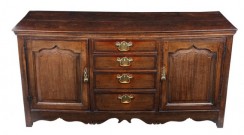Antique tables come in a number of styles, designs and ages and many have the potential to be refurbished, however refurbishing a table requires a great deal of care and planning. Read on and we will tell you how to upcycle tired old tables and make them valuable, ‘modern’ pieces. Additional information is always available online so be sure to check out a few sites in addition to what you read here!
Before you even begin!
Before beginning the process, carefully check all areas of the table for damages and loose joints. Check the entire surface and look for any damages such as cracks and dents.
Preparing the Surfaces
Prepare the surface of the table and legs by repairing and filling in wood putty or filler using a putty knife. Make sure to fill in all the crevices and damaged areas with the filler. Using a putty knife scrape off any excess. Make sure it is levelled well and is seamless with the rest of the surface.
Allow the putty or the filler to dry out overnight. It usually takes over 24 hours to dry. Make sure it is thoroughly dry. If not completely dry allow it to dry a little until the filler or the putty is hardened.
Sanding
Sand the surfaces using very high grit sandpaper. If damaged or fallen off, re-apply the putty and allow it to dry. When all areas are sufficiently dried, lightly sandpaper the surfaces with fine grit sandpaper for a smooth finish. It helps in the adhesion of the polyurethane varnish.
Clean off all the dust particles with a brush or vacuum and wipe down with a dampened rag. It will remove any residues of fine dust.
Sealing
Apply a fast drying sealer.
Polyurethane varnish
Polyurethane varnish is a very easy to use and versatile synthetic varnish popularly used for sealing and finishing wood. It is cheap and easy to use. Polyurethane is available in a range of finishes and for different purposes. Depending on your requirement it is available in matte or gloss finishes and even for water resistant outdoor use. It is resistant to abrasion and an ideally suitable varnish for hardwood surfaces.Make sure the area you are working in is adequately ventilated as polyurethane yields harsh fumes. Make sure you have a good stock of newspapers and old towels to wipe up careless spills before it becomes too difficult to clean up as polyurethane bonds to surfaces very fast.
Wipe the surface area clean using a clean tack cloth or a lint-free cloth lightly soaked in mineral spirits to remove all dust and small wood particles. It is best to wipe down after sanding a small section at a time. When completely done, give it a final wipe down and you are ready to proceed.
Applying three coats of varnish
Stir the polyurethane varnish gently; using a paint stir stick making sure no part of the flattening agent remains at the bottom. Do not over stir too vigorously, as this will cause bubbles to form that will eventually mar the finish.
Make sure your brush is clean and dry before dipping it into the can of polyurethane varnish. Wipe off the excess varnish on the inside rim of the can.
Tip: Fold a stiff wire over the centre of the can and tape it down to the sides of the can. Use this to wipe the excess off the brush. It keeps the can clean and easy to close.
The first coat
Start applying the first coat of polyurethane varnish slowly in long, broad strokes keeping to the grain of the wood spreading it thinly to avoid drips.
Leave it to dry for at least 24 hours before applying the next coat.
Test for dryness in an obscure area by running a nail. If it still feels soft, let it stand for a further period. Avoid applying the brush over a partially dried patch as it will reduce the sheen, resulting in a finish that is more matte than intended.
When the first coat has thoroughly dried, use a grit sandpaper to lightly sand the surface. Then, using a clean tack cloth wipe off the sanding dust.
The second coat
Apply the second coat of varnish in the same manner as you did the first coat. Leave to dry another 24 hours and test as stated earlier.
The final coat
A third coat will give you added sheen and longer durability also following the above method.
The last coat is not sanded. A fourth coat is rarely needed, but no more is needed in completing your project.
Even though Polyurethane is less sensitive to humid conditions, applying the varnish on a very humid day will cause a milky and cloudy appearance.
Photo: Manzabar
Are you looking to buy property in UK ? Hurghada , Scotland , Istanbul , Sahl Hasheesh , Dubai
Are you looking to rent property in UK ? London , Manchester , Reading , Leeds , Cardiff
Residential Property for sale in London , Apartment for sale in London , Bungalow for sale in London , House for sale in London , Land for sale in London , Retail for sale in London , Semi-detached house for sale in London , Duplex for sale in London








Author
Carol McDonald